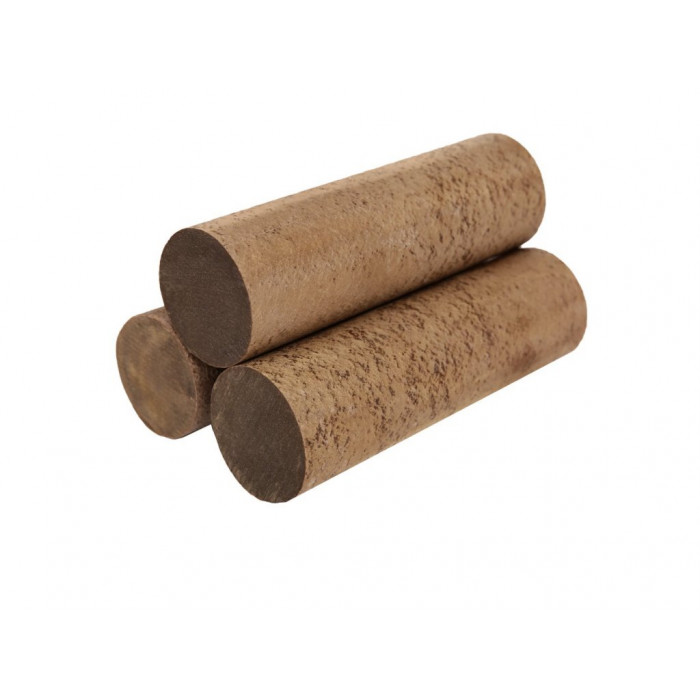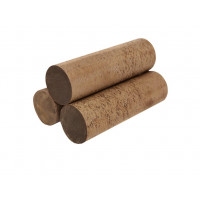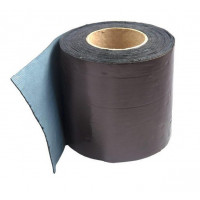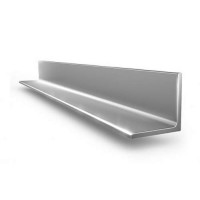Ebonite rod Ф 40 мм is a highly vulcanized product of natural or synthetic sulfur rubber. The bound sulfur in ebonite is about 32%, which corresponds to the formula (C6H9S)2. Ebonite is usually dark brown or black in color.
Ebonite lends itself well to machining; non-hygroscopic, does not adsorb gases, resistant to acids and alkalis, swells in carbon disulfide and petroleum products, dissolves in paraffin at temperatures above 300°C with the release of hydrogen sulfide. Under the action of sunlight due to oxidation, the insulating properties of ebonite decrease. Ebonite softens usually between 70°C and 80°C and hardens again when cooled; at temperatures ≥200°С it chars without melting.
The rubber used for the manufacture of ebonite must be completely free from contaminants that lead to the formation of bubbles, which reduce electrical insulating properties and make machining difficult. The most valuable grades of ebonite contain only rubber (~66 parts by weight) and sulfur (~34 parts by weight).
Ebonite dust, talc, pumice, white soot, diatomaceous earth and others are used as fillers for ebonite. Soot is introduced in small amounts of 3-5%) to color ebonite black (high doses of soot worsen the dielectric properties).
Ebonite is produced in the form of plates, rods and tubes and is used for the manufacture of electrical products, especially those that must be resistant to acids (accumulator tanks), as well as containers for storing acids and alkalis.
Physical Properties
Unlike elastic rubber, ebonite does not show high elasticity at ordinary temperatures and resembles hard plastic. Ebonite becomes highly elastic at temperatures above +55 °C.
density 1.15-1.68 g/cm³;
Young's modulus 2–3 GPa (20⋅10³—30⋅10³ kgf/cm²);
tensile strength 52-67 MN/m² (520-670 kgf/cm²),
specific volume electrical resistance 1014—1015 Ohm⋅cm.
Beneficial features
well amenable to mechanical processing;
non-hygroscopic;
gas-tight;
acid-resistant;
resistant to the action of bases, salts, vegetable and animal fats;
good electrical insulator;
high relative dielectric constant;
Destruction
Ebonite is destroyed by strong oxidizing agents, aromatic and chlorinated hydrocarbons. Ebonite oxidizes in bright light, acquiring a greenish tint. It chars at high temperatures.
In production
Ebonites were used as electrical insulators and acid-resistant materials in the production of electrical insulating parts of devices, in the rubberizing of various containers for aggressive liquids, cases of acid batteries, etc.
Ebony was also used as a substitute for expensive materials like ebony, ivory, horn, or tortoiseshell.
In industry
At the beginning and middle of the 20th century, combs, knife handles, mouthpieces for cigarettes and smoking pipes, cases of fountain pens, in music - gramophone records, mouthpieces for clarinets, saxophones and bassoons were made from ebonites. Pipes, flutes and clarinets are also made.
Ebonite rods of a standard size are produced with a diameter of 0.5-7.50 cm, a length of not more than 300 cm. Blanks of rods (sticks) are made by profiling on a worm press. After that, the blanks are cut to the desired length and cooled in water. For shrinkage, the rods are placed in tubes of larger diameter and kept for 8-12 hours. Vulcanization of ebonite rods is carried out in baths, boilers filled with water.
Rods are the main form of production and supply of ebonite. According to GOST 2748-77, they can have a diameter of 5 to 75 mm with a minimum length of 0.25 m. They are produced by profiling followed by cooling and controlled shrinkage from ebonite. The material is a vulcanized, natural or artificial, high sulfur rubber. The share of the latter can be 34-35%. Sulfur determines the key differences between ebonite and rubber: increased hardness and, in some cases, brittleness. The cost depends on the purity of the raw material. Less impurities contain ebonite - the rod is more expensive.
However, to change some characteristics, add to it:
ebonite dust - to reduce the cost;
polymer resins - improve machinability;
pumice and talc - increase hardness and rigidity.
ebonite properties
Ebonite differs from rubber in increased hardness - its second name is "hard rubber". At the same time, the main property of rubber - high electrical insulating ability - is preserved.
Ebonite rods are stable in the range from -50 °C to +60 °C. With a decrease in temperature, the fragility of the product increases, with an increase, it becomes more plastic (up to fluidity). Properties are restored as soon as it returns to the working temperature corridor.
Key features of the material:
resistant to acids, alkalis, salts, fats;
quickly processed mechanically - ebonite rods are bought not only for their molding at elevated temperatures, but also for the manufacture of shaped fromdeliy by cutting, milling, drilling;
completely non-hygroscopic, does not swell under the influence of water vapor, does not pass gas.
The material is sensitive to strong acids, paraffin and aromatic hydrocarbons.
Sunlight causes it to oxidize. This changes, from black or brown to yellowish-green, the color of the material. Its ability as a dielectric also decreases. This must be remembered if you decide to buy ebonite rods for the future.
You can buy Ebonite rod Ф 40 мм from us at the best price in Ukraine. A wide range of products allows us to quickly and efficiently fulfill any order, helping to complete any construction work on time.
No questions about this product, be the first and ask your question.




